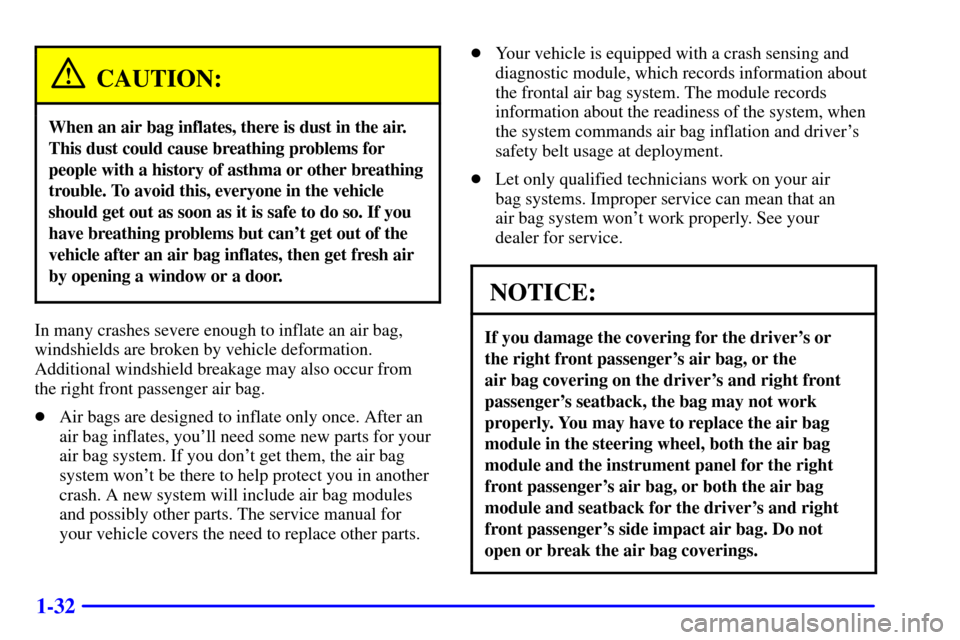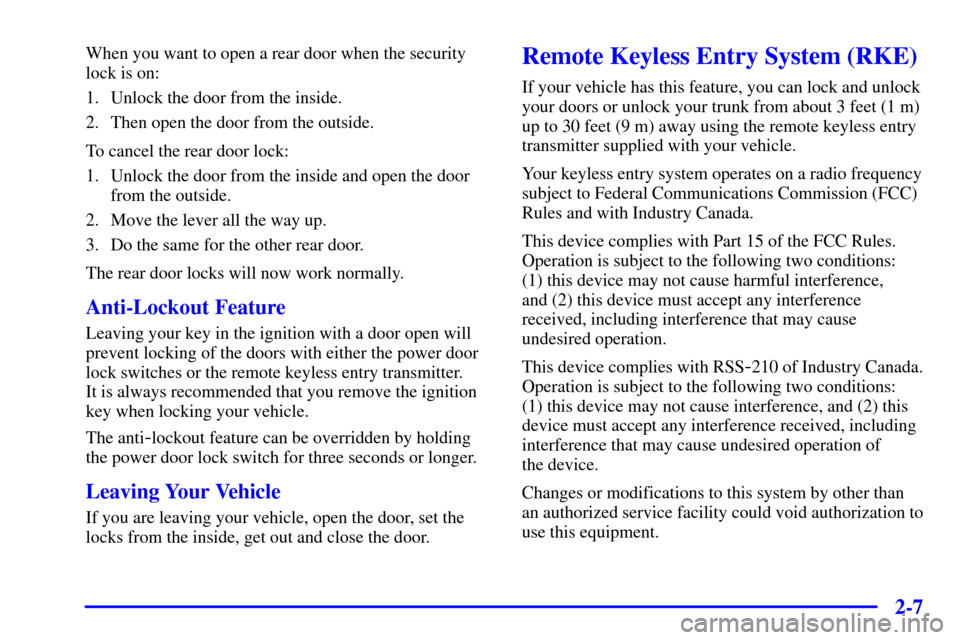Page 2 of 321
Every
2000 Catera
under warranty is
backed with the
following
services:
Free lockout assistance
Free dead-battery assistance
Free out-of-fuel assistance
Free flat-tire change
Emergency towing
1-800-882-1112
that provides in an emergency:
1-800-882-1112
Bumper-to-Bumper
4-years/50,000 miles (80 000 km)
Limited Warranty
Courtesy
Transportation
Deluxe Trip
Routing
Page 6 of 321
Fuel
Checking Fluids and Lubricants
Engine Air Cleaner/Filter
Passenger Compartment Air Filter
Brakes
Bulb ReplacementWindshield Wiper Blade Replacement
Tires and Wheels
Appearance Care
Electrical System/Fuses and Circuit Breakers
Capacities and Specifications
Normal Maintenance Replacement Parts
Table of Contents (cont'd)
Maintenance Schedule Service and Appearance Care
Section
6
Scheduled Maintenance
Owner Checks and Services
Periodic Maintenance InspectionsRecommended Fluids and Lubricants
Maintenance Records
See separate Maintenance Schedule Booklet
Page 7 of 321
Table of Contents (cont'd)
Customer Assistance Information
In the Index you will find an alphabetical listing of almost every subject in this manual.
You can use it to quickly find something you want to read.
Section
7Customer Satisfaction Procedures
Customer Assistance Offices
Roadside Assistance and Courtesy Transportation
Warranty Information (See Warranty Manual)
Reporting Safety Defects on page 7-10
Service Publications
Index
Section
8
Please refer to the last page of this manual for your Service Station Guide
Page 8 of 321
vi
GENERAL MOTORS, GM and the GM Emblem,
CADILLAC, the CADILLAC Crest & Wreath and the
name CATERA are registered trademarks of General
Motors Corporation.
This manual includes the latest information at the time
it was printed. We reserve the right to make changes
in the product after that time without further notice.
For vehicles first sold in Canada, substitute the name
ªGeneral Motors of Canada Limitedº for Cadillac Motor
Car Division whenever it appears in this manual.
Please keep this manual in your vehicle, so it will be
there if you ever need it when you're on the road. If you
sell the vehicle, please leave this manual in it so the new
owner can use it.
We support voluntary
technician certification.
For Canadian Owners Who Prefer a
French Language Manual:
Aux propri‡taires canadiens: Vous pouvez vous
procurer un exemplaire de ce guide en fran†ais chez
votre concessionaire ou au:
DGN Marketing Services Ltd.
1577 Meyerside Dr.
Mississauga, Ontario L5T 1B9
Page 12 of 321
For
a More
Detailed Look at
What's Under the Hood
See Section 6
Tire Pressure
See Section 6
Service Station Guide
Oil Viscosity
Engine Oil
See Section 6
Engine Oil Dipstick
See Section 6
Remote Fuel
Door Release
See Section 6
Premium Fuel Recommended
Use unleaded gas only,
91 Octane or higher.
See Section 6
Cooling System
See Section 5Hood Release
See Section 6
Windshield Washer
Fluid
See Section 6
Battery
See Section 6
Page 44 of 321

1-32
CAUTION:
When an air bag inflates, there is dust in the air.
This dust could cause breathing problems for
people with a history of asthma or other breathing
trouble. To avoid this, everyone in the vehicle
should get out as soon as it is safe to do so. If you
have breathing problems but can't get out of the
vehicle after an air bag inflates, then get fresh air
by opening a window or a door.
In many crashes severe enough to inflate an air bag,
windshields are broken by vehicle deformation.
Additional windshield breakage may also occur from
the right front passenger air bag.
�Air bags are designed to inflate only once. After an
air bag inflates, you'll need some new parts for your
air bag system. If you don't get them, the air bag
system won't be there to help protect you in another
crash. A new system will include air bag modules
and possibly other parts. The service manual for
your vehicle covers the need to replace other parts.�Your vehicle is equipped with a crash sensing and
diagnostic module, which records information about
the frontal air bag system. The module records
information about the readiness of the system, when
the system commands air bag inflation and driver's
safety belt usage at deployment.
�Let only qualified technicians work on your air
bag systems. Improper service can mean that an
air bag system won't work properly. See your
dealer for service.
NOTICE:
If you damage the covering for the driver's or
the right front passenger's air bag, or the
air bag covering on the driver's and right front
passenger's seatback, the bag may not work
properly. You may have to replace the air bag
module in the steering wheel, both the air bag
module and the instrument panel for the right
front passenger's air bag, or both the air bag
module and seatback for the driver's and right
front passenger's side impact air bag. Do not
open or break the air bag coverings.
Page 45 of 321

1-33 Servicing Your Air Bag-Equipped Vehicle
Air bags affect how your vehicle should be serviced.
There are parts of the air bag systems in several places
around your vehicle. Your dealer and the service manual
have information about servicing your vehicle and the
air bag systems. To purchase a service manual, see
ªService and Owner Publicationsº in the Index.
CAUTION:
For up to 10 seconds after the ignition key is
turned off and the battery is disconnected, an
air bag can still inflate during improper service.
You can be injured if you are close to an air bag
when it inflates. Avoid wires wrapped with
yellow felt, wires wrapped with yellow tape or
yellow connectors. They are probably part of
the air bag systems. Be sure to follow proper
service procedures, and make sure the person
performing work for you is qualified to do so.
The air bag systems do not need regular maintenance.
Safety Belt Pretensioners
Your vehicle has safety belt pretensioners. You'll find
them on the buckle end of the safety belts for the
driver and right front passenger. They help the safety
belts reduce a person's forward movement in a
moderate to severe crash in which the front of the
vehicle hits something.
Pretensioners work only once. If they activate in a crash,
you'll need to get new ones, and probably other new
parts for your safety belt system. See ªReplacing
Restraint System Parts After a Crashº in the Index.
Rear Seat Passengers
It's very important for rear seat passengers to buckle up!
Accident statistics show that unbelted people in the rear
seat are hurt more often in crashes than those who are
wearing safety belts.
Rear passengers who aren't safety belted can be thrown
out of the vehicle in a crash. And they can strike others
in the vehicle who are wearing safety belts.
Page 72 of 321

2-7
When you want to open a rear door when the security
lock is on:
1. Unlock the door from the inside.
2. Then open the door from the outside.
To cancel the rear door lock:
1. Unlock the door from the inside and open the door
from the outside.
2. Move the lever all the way up.
3. Do the same for the other rear door.
The rear door locks will now work normally.
Anti-Lockout Feature
Leaving your key in the ignition with a door open will
prevent locking of the doors with either the power door
lock switches or the remote keyless entry transmitter.
It is always recommended that you remove the ignition
key when locking your vehicle.
The anti
-lockout feature can be overridden by holding
the power door lock switch for three seconds or longer.
Leaving Your Vehicle
If you are leaving your vehicle, open the door, set the
locks from the inside, get out and close the door.
Remote Keyless Entry System (RKE)
If your vehicle has this feature, you can lock and unlock
your doors or unlock your trunk from about 3 feet (1 m)
up to 30 feet (9 m) away using the remote keyless entry
transmitter supplied with your vehicle.
Your keyless entry system operates on a radio frequency
subject to Federal Communications Commission (FCC)
Rules and with Industry Canada.
This device complies with Part 15 of the FCC Rules.
Operation is subject to the following two conditions:
(1) this device may not cause harmful interference,
and (2) this device must accept any interference
received, including interference that may cause
undesired operation.
This device complies with RSS
-210 of Industry Canada.
Operation is subject to the following two conditions:
(1) this device may not cause interference, and (2) this
device must accept any interference received, including
interference that may cause undesired operation of
the device.
Changes or modifications to this system by other than
an authorized service facility could void authorization to
use this equipment.